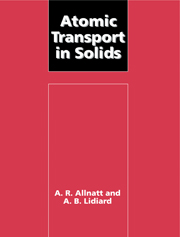Book contents
- Frontmatter
- Contents
- Preface
- List of principal symbols
- 1 Atomic movements in solids – phenomenological equations
- 2 Imperfections in solids
- 3 Statistical thermodynamics of crystals containing point defects
- 4 Non-equilibrium thermodynamics of atomic transport processes in solids
- 5 Some applications of non-equilibrium thermodynamics to solids
- 6 Microscopic theories – the master equation
- 7 Kinetic theory of relaxation processes
- 8 Kinetic theory of isothermal diffusion processes
- 9 The theory of random walks
- 10 Random-walk theories of atomic diffusion
- 11 Transport coefficients of dilute solid solutions – results and applications
- 12 The evaluation of nuclear magnetic relaxation rates
- 13 Theories of concentrated and highly defective systems
- References
- Index
Preface
Published online by Cambridge University Press: 28 December 2009
- Frontmatter
- Contents
- Preface
- List of principal symbols
- 1 Atomic movements in solids – phenomenological equations
- 2 Imperfections in solids
- 3 Statistical thermodynamics of crystals containing point defects
- 4 Non-equilibrium thermodynamics of atomic transport processes in solids
- 5 Some applications of non-equilibrium thermodynamics to solids
- 6 Microscopic theories – the master equation
- 7 Kinetic theory of relaxation processes
- 8 Kinetic theory of isothermal diffusion processes
- 9 The theory of random walks
- 10 Random-walk theories of atomic diffusion
- 11 Transport coefficients of dilute solid solutions – results and applications
- 12 The evaluation of nuclear magnetic relaxation rates
- 13 Theories of concentrated and highly defective systems
- References
- Index
Summary
In any area of physical science there are stages in its historical development at which it becomes possible and desirable to pull its theory together into a more coherent and unified whole. Grand examples from physics spring immediately to mind – Maxwell's electro-magnetic theory, Dirac's synthesis of wave-mechanics and matrix mechanics, the Salam–Weinberg electro-weak theory. Yet this process of unification takes place on every scale. One example of immediate concern to us in this book here is afforded by the emergence of the thermodynamics of irreversible processes, where the coming together of separate strands of theory is made plainly visible in the short book by Denbigh (1951). In connection with imperfections in crystal lattices the Pocono Manor Symposium held in 1950 (Shockley et al. 1952) might be said to mark another such stage of synthesis. At any rate a great growth in the understanding of the properties of crystal imperfections occurred in the years following and this carried along a corresponding achievement in understanding atomic transport and diffusion phenomena in atomic terms. Around 1980, in the course of a small Workshop held at the International Centre for Theoretical Physics, Trieste we concluded from several observations that such a stage of synthesis could soon be reached in the study of atomic transport processes in solids. First of all, despite the great growth in detailed knowledge in the area, the theory, or rather theories, which were used to relate point defects to measurable quantities (e.g. transport coefficients of various sorts) were recognizably still largely in the moulds established considerably earlier in the 1950s and 1960s, notwithstanding the advances in purely numerical techniques such as molecular dynamics and Monte Carlo simulations.
- Type
- Chapter
- Information
- Atomic Transport in Solids , pp. xv - xxPublisher: Cambridge University PressPrint publication year: 1993

